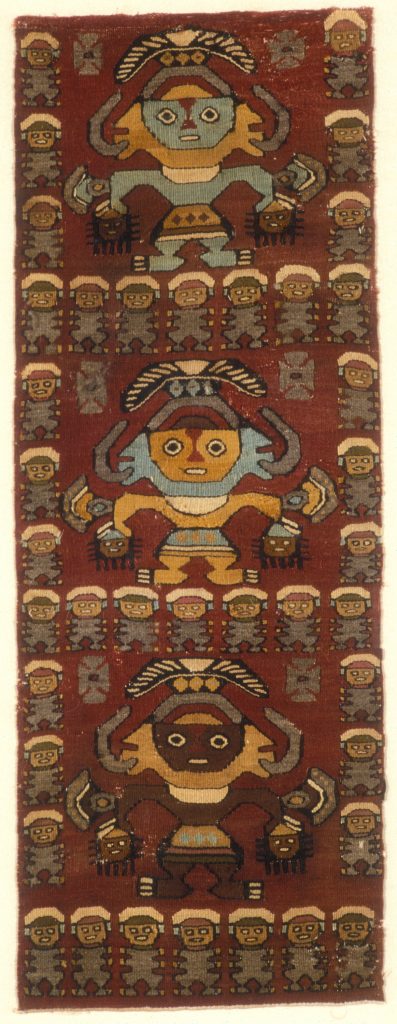Panel (perhaps portion of a loincloth tie-end) (work of art)
Artwork Info
About
Key Ideas about this Work of Art
- This panel is a tapestry weave. A tapestry is a piece of thick fabric with images woven into its cloth. It appears that the panel has been cut from a larger garment, perhaps the tie-end of a loincloth. A loincloth is a piece of cloth that hangs down from around the waist, sometimes worn by men in tropical climates where it is too hot to wear anything else.
- The tapestry displays the images of three warriors holding “trophy heads” of people. Their heads had been cut off and used as prizes or trophies of war. Each large figure is framed by rows of smaller human figures that may represent war captives. The three large figures wear the typical Chimú-style, crescent-shaped headdress that indicates supernatural status.
- The Chimú was a South American society who maintained the largest and most important political system in Peru before the Inca.
Learn More
This woven tapestry panel is embellished with the images of three warriors holding trophy heads. Each large figure is framed by rows of smaller human figures that may represent war captives. The three large warrior figures wear a Chimú-style, crescent-shaped headdress, which indicates their supernatural status.
This panel has been cut from a larger garment, perhaps the tie-end of a loincloth, the typical precontact male garment. It was worn by tying the cords around the waist from front to back, pulling the long fabric between the legs to the back, and lifting the free end up under the ties to hang loose at the wearer’s back. This free-hanging panel was often woven as an elaborate tapestry, usually with smaller, matching panels at the ends of the tie cords.
Headdresses like the ones worn by the warrior figures on this panel have been found in the tombs of elite Peruvian figures in the areas where the Chimú settled. The headdresses were often made of gold or other precious materials, which indicated the high status of the individual with whom it was buried.
tags: fashion, repetition, pattern, textile
Additional Resources
Resources for Teachers:
- Examine a similar Peruvian tunic from The Metropolitan Museum of Art.
- View a Chimú loincloth from the National Gallery of Australia.
Resources for Students:
- Learn more about Chimú culture.
- View a tunic with a similar Chimú-style headdress from the Metropolitan Museum of Art.

